HHC Details – At Rest & In Motion
The Horse Health Check: A Systematic Method of Examination
Written by Dr. Art King and Gayle Ecker. Not to be copied without written permission of the authors.
Every horse person should learn how to check a horse’s physical condition for any tell-tale signs of illness, injury, or fatigue. The health check is a critical factor with all competitions, and it is very useful in day to day management as well. Many potentially serious conditions can be picked up at an early stage by this simple series of tests. No sophisticated equipment is required.
A stethoscope, a watch capable of indicating seconds and a thermometer is all the equipment one needs, along with a basic understanding of the difference between what is normal and abnormal for the various areas of the horse that can be examined. With a little practice, one can examine the horse in less than 5 minutes using a systematic method of examination. A complete examination involves two parts: an examination of the horse at rest and in motion.
The Horse at Rest
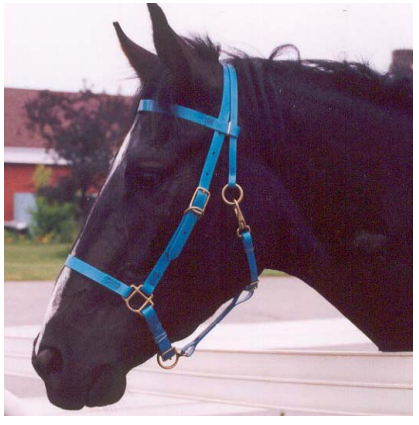
Choose an open area such as a large box stall or wide alley way. If the horse is quiet, it can be tied or have an assistant hold the horse for you. You should approach the horse’s head from the front and to the left of the horse. First of all, note the horse’s general condition and attitude. Is the horse over or underweight? You should be able to feel the ribs when you run your fingers across, but the ribs should not be obvious. Is the hair coat sleek or dull? Is the horse alert or lethargic? Since a temperature reading with a conventional mercury bulb thermometer takes about 1 minute, time can be saved if the thermometer is placed in the rectum and restrained there with the clip attached to the tail while continuing with the examination.
Eyes/Ears/Nose
Check the eyes for redness, puffiness or discharge as this indicates a problem. A glassy-eyed or sunken eyed look is also an indication of a problem. The ears should be alert and moving.
Ears that are slow to respond or that are hanging loosely out to the sides can indicate a problem in the awake horse. The nose should be free of nasal discharge and the lining of the nasal passages should not be red. Check the nostrils for discharges. Normally there is no discharge, or a slight watery, clear discharge may be present. Any bloody, purulent, yellowish, creamy white or greenish coloured discharge is abnormal and should be investigated.
Mucous Membranes/Capillary Refill
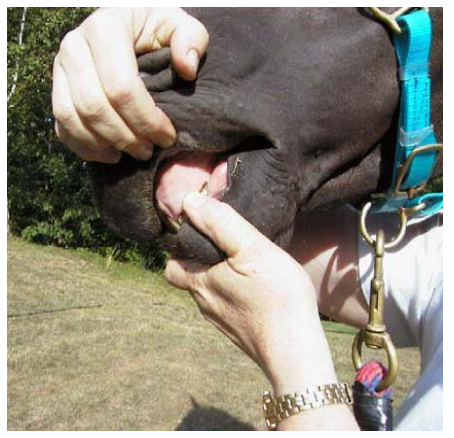
Lift the upper lip of the horse and look at the gums above the teeth (also called the mucous membranes). Mucous membranes should be a healthy pink, shiny, moist and slippery. If they are pale, dry or tacky this can indicate dehydration. Colours such as pale white, jaundiced, brick red, bluish, purplish, or muddy are indicative of a serious problem.
Next, press your thumb or finger on the gum to “blanch” the area (push the blood out from under the finger) to determine capillary refill time. Upon release of the pressure, count the seconds that elapse while the colour returns. Normal time is up to 1.5 seconds. Delays for 2 to 3 seconds are cause for concern. Delays beyond 4 seconds are serious. Delayed capillary refill time is an indication of reduced blood circulation due to reduced volume (blood loss or dehydration) and/or decreased blood pressure (shock).
Jugular Refill
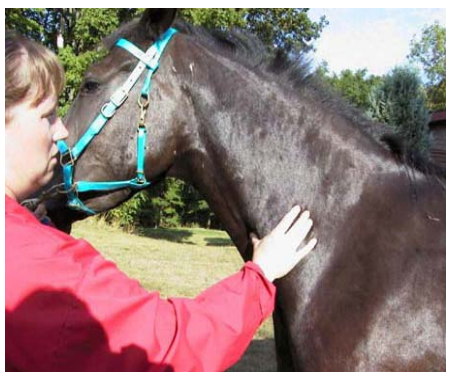
The jugular refill time, like the capillary refill time, is an indicator of the status of the circulatory system. Find the jugular groove on the side of the neck. Run your thumb along the groove from the top to two-thirds down, then gently press your thumb on the jugular grove with enough pressure to squeeze the blood from the vein. The refilling is seen as the collapsed vein becomes distended as it refills. Watch how fast it “fills”. A refill time of up to one or two seconds is normal. As with capillary refill time, a delay beyond four or five seconds is cause for concern.
Skin Pinch
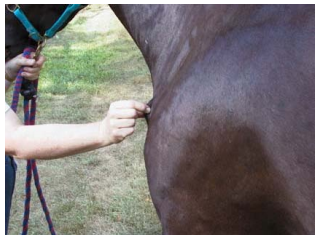
While dehydration leads to changes in a number of the areas examined, the most common means to quickly check hydration is the skin pinch test. As the animal becomes dehydrated, the skin elasticity decreases due to loss of water from the skin. When the skin on the point of the shoulder is pinched and pulled gently away, it should then snap back quickly upon release. Take a fold of skin between the thumb and forefinger, lift it away from the underlying tissues, twist slightly and release. A skin fold or “tent” that remains for over two seconds indicates dehydration. A delay of 5 seconds is serious. It is important to know the normal skin pinch results on your horse as there can be a variation due to age and breed. For this reason, it is important to test the same area of the skin each time to maintain consistency of results.
Heart Rate/Pulse
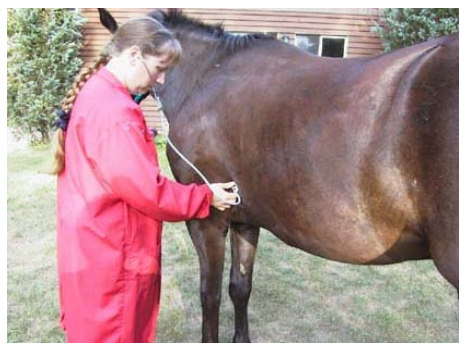
To take the heart rate or pulse, place the bell of the stethoscope on the chest wall, just behind the elbow. The heart rate is heard as “lub-dup”. Listen for the lub-dup which is one beat. You should hear a clear two-beat sound for each heartbeat. Count the beats for 15 seconds and multiply by 4. Heart rates of 25-40 beats per minute are normal in resting horses. A fit horse should recover to a rate of 64 to 68 beats per minute within 10 minutes of the exercise. After exercise, the heart rate should drop steadily. Higher rates during recovery from exercise may indicate over-work, fatigue, heat stress, dehydration, pain or illness.
Gut Sounds
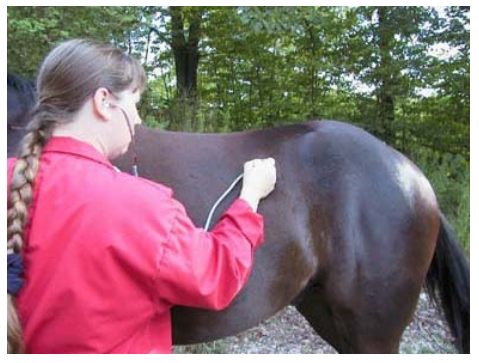
Gut sounds are evaluated with the stethoscope by listening over the upper and lower flank on both left and right sides. Normal gut sounds are heard as bubbling and gurgling every 5-10 seconds. The owner should practice listening to normal horses to get an understanding of normal gut sounds. Abnormal sounds such as pinging, ringing, or echoes of water dripping into a well would be cause for concern. The sounds can vary not only in quality and character but also in frequency. The absence of gut sounds is very serious and usually warrants treatment if no improvement is noted within 30 minutes.
Respiration Rate
To measure the respiratory rate, watch the flank movement or the flare of the nostrils. Count the number of breaths the horse has taken in 15 seconds and multiply by 4. Normally, the respiratory to heart rate is one to four at rest(about 8 – 15 breaths per minute). Elevated respiratory rates may be observed in excitable horses or during hot/humid weather when the horse is trying to cool itself by panting. Breathing in and out should be regular and without effort or sound. Laboured breathing, wheezing, grunting, groaning, coughing or other sounds indicate a problem. The rate and depth of respiration can vary widely among horses. Because so many factors affect the respiratory rate at any one time, it is not possible to correlate respiratory rate and depth to physical fitness.
Checking the Body

The withers, shoulders, back, croup/rump and girth areas should be palpated for evidence of sores, pain, bumps and tight musculature. The aim is to detect any pain, sensitivity, or tightness that would impair the horse’s athletic ability or cause pain and suffering during exercise. The left foreleg is palpated for pain, swelling or heat, especially in the joints, ligaments and tendons, and splint area. Lift the foot and check the condition, type, and general fit of the shoe. Note any cracks, founder lines, etc. that may be evident on the hoof. Repeat this examination on the left hind limb and then go to the right fore and right hind limb.
Heat/Pain/Swelling
Evidence of heat or swelling evident in any area on the body is cause for concern. If the horse is in pain or exhibits a response such as pulling away due to pain, this needs to be investigated by a veterinarian.
Temperature
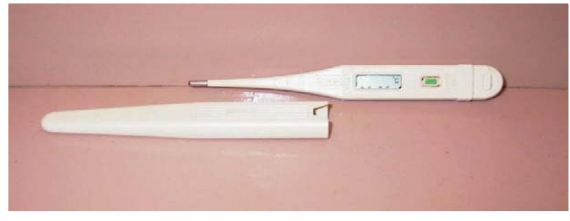
To take the temperature, place the lubricated thermometer into the anus and gently press it against the wall of the rectum. Normal temperature for a resting horse is 37.5 to 38˚C (99.5 to 100.5˚F). Rectal temperature of > 40.5˚C is serious. If the horse has been exercising it may increase to 3˚9C.6 but should not exceed 40.5˚C and should fall quickly when exercise has stopped.
Remove the thermometer, note the temperature, and check the tail and anal tone. The anus should constrict immediately in response to slight digital pressure. The tail should clamp in reflex when first touched. A flaccid tail and loose anus are found in exhausted horses as well as in some nervous system diseases.
Appetite and Water Consumption
Normal horses eagerly anticipate the daily feeding. Horses that exhibit disinterest in their food, become picky eaters or go off feed completely may be developing a problem and this needs to be investigated. The horse will generally drink roughly equivalent amounts of water daily, with adjustments for temperature, diet, seasonal and exercise changes. It is important to monitor water consumption daily for optimal health.
Manure/Urination
The manure should be formed into moist balls. If the manure is too dry, or too loose, this may be an indication of a problem or change in diet, water consumption, or other factors. The amount of manure passed each day is also important to notice. The amount , colour and frequency of urination should be noted as well as posture while urinating.
Skin/Mane/Tail
The skin should be observed for flaking, oozing or signs of irritation. Hair loss should also be noted.
The Horse in Motion
The next part of the examination is to assess the horse while trotting. Have an assistant trot the horse away from you on a loose lead and then back towards you again so you can assess the parameters described in the sections below.
Gait / Attitude/ Impulsion
The examination in motion is done with the assistance of the handler who will trot the horse in a straight line for approximately 40 meters (125’) away from and then toward the owner. The footing in the trotting area should be level, even and reasonably firm. Trot the horse on a loose rein at a steady slow trot, taking care to travel to the left of the horse, rather than in front of the horse. This ensures that the view is not obstructed. Do not hold the horse with a short lead as this exaggerates or restricts normal head motion.
Note any of the following motions in the gait: hiking, head bobbing or swaying, hopping, as well as head, back and tail carriage. Listen for any unevenness of hoof beats on the ground.
Learn the normal attitude of your horse. Step back and look at the whole horse. The horse should be bright and alert and willing to trot. A horse that seems sour, disinterested, dull or unwilling to move may not be feeling well.
Impulsion is shown when the horse pushes off energetically from the ground. The horse’s movement should be free, willing and eager. Stride length and height should also be noted as this relates to quality of gait.
Cardiac Recovery Index (CRI)
The cardiac recovery index is a useful indicator of a horse’s condition, especially if it is used at rest intervals during or after exercise/competition. The owner takes the horse’s heart rate immediately prior to trotting the horse a distance of 38 meters (125’) away and then back to the starting point (76m/250’ total). The heart rate is re-taken exactly 60 seconds (one minute) from the start of the trot. The two heart rates are compared and should be within a few beats of one another. If the post-trot reading is eight or more beats/minute higher than the pre-trot reading, the horse should be carefully evaluated. Assuming that excitement did not cause the higher reading, one should consider injury, fatigue, dehydration or other causes that may be the underlying cause of the elevated reading.
- Equal or lower than 1st reading = Fit to continue
- 4 bpm higher than 1st reading = Not fully recovered/repeat test after additional 10 minutes of rest.
- 8 bpm higher than 1st reading = Not recovering/cease exercise or workout
A horse that does not pass the CRI test within 30 minutes of rest should cease all exercise and be carefully monitored by a veterinarian.
Conclusion
Compare the results of your assessment to the colour-coded chart called The Horse Health Check. When all the parameters are in the green zone, then you have a healthy horse with no signs of a problem. If any of the parameters are in the Yellow zone, then you need to slow down and/or stop your horse so that it can be further assessed or to give it appropriate recovery time. If any of the parameters are in the red zone, you need to contact a veterinarian as soon as possible so the horse can be medically assessed, as there could be a serious condition present and medical assistance is required. Have the complete results of the Horse Health Check written down and available so you can report this to the veterinarian.
You are now on your way to becoming an educated horse owner who will be able to pick up warning signs before they become more serious.
(Information provided in the horse health check article is intended to assist the horse owner and is not for medical diagnosis. Discuss your findings with your veterinarian.)
Horse Health Check Infosheet – printable PDF version of information above






